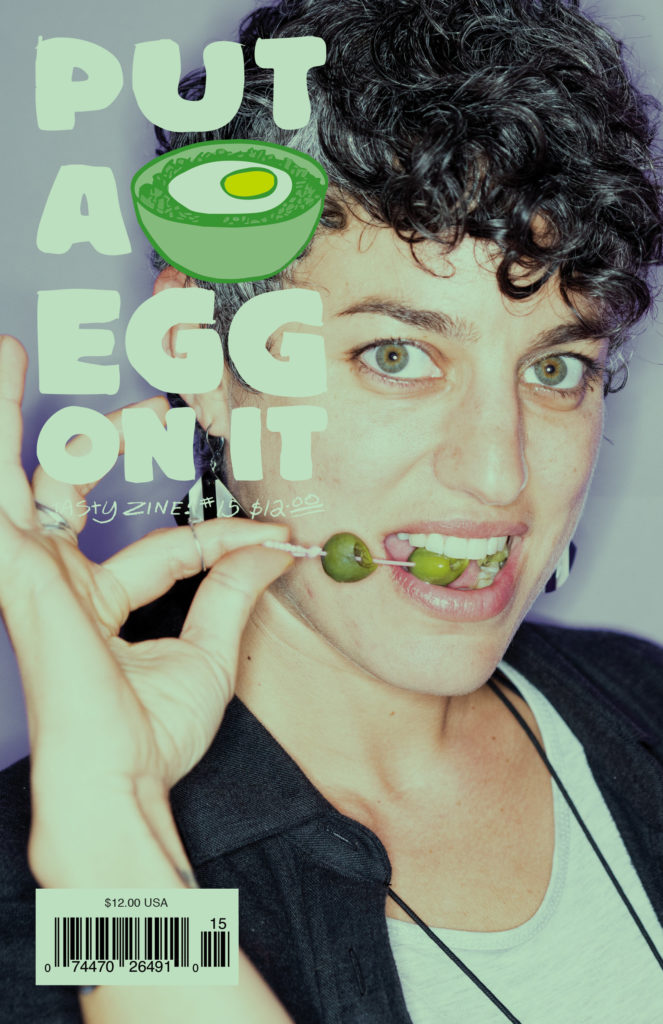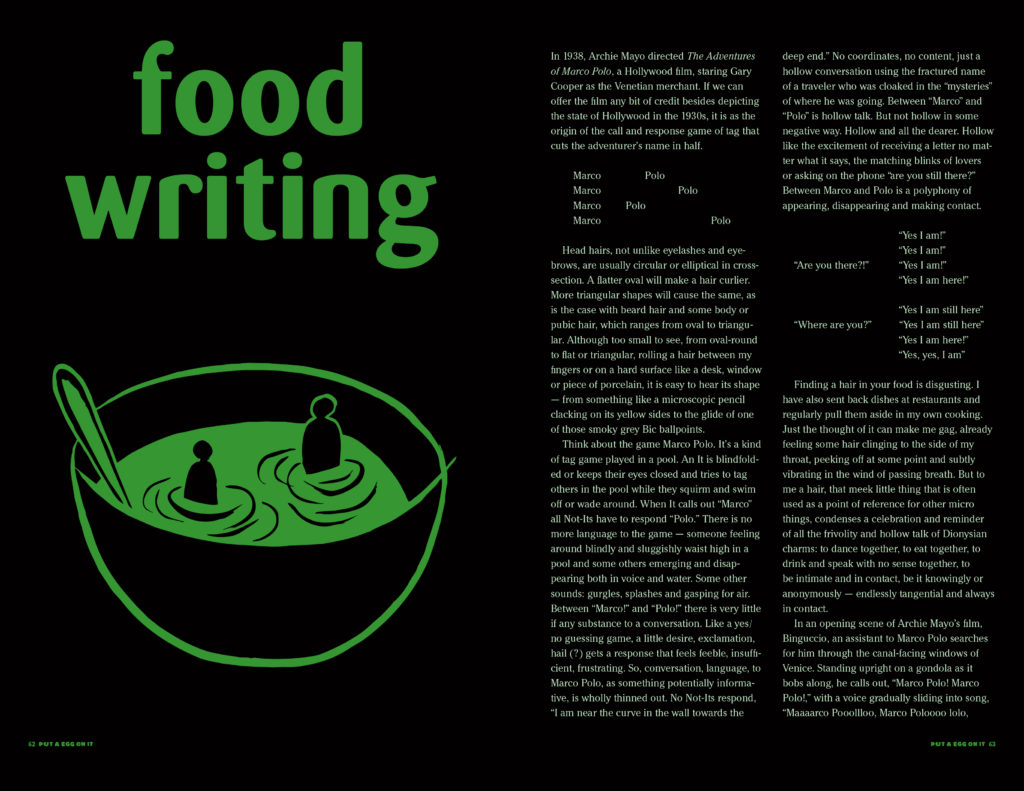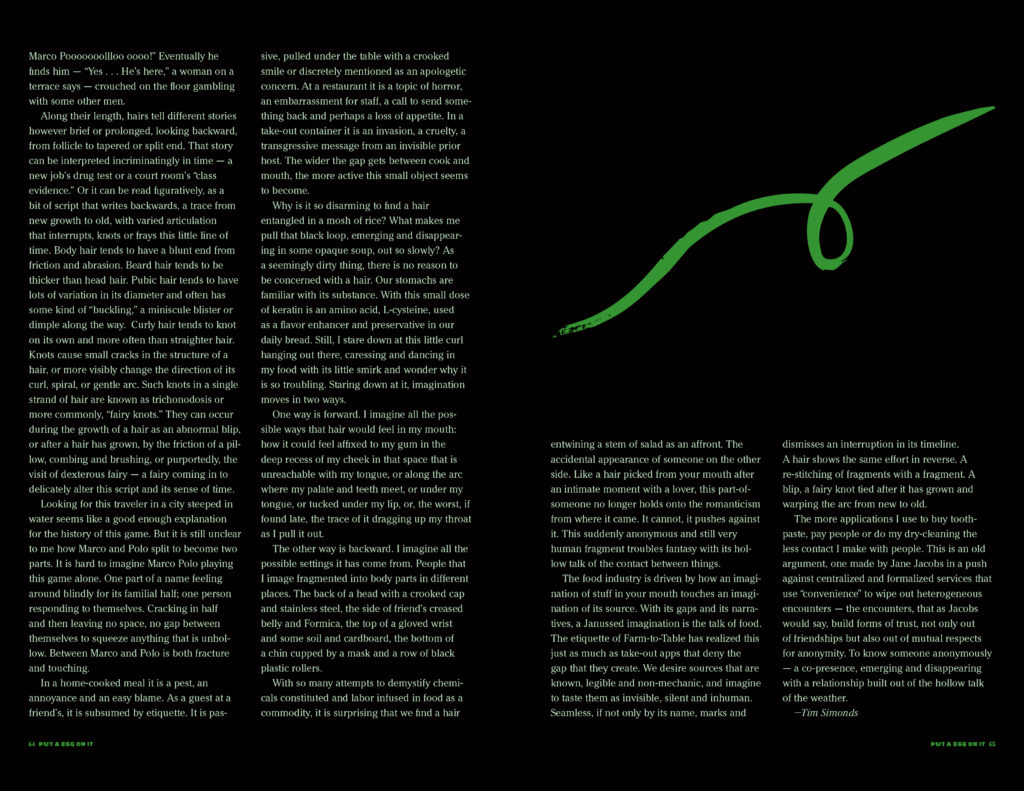Put A Egg On It
Published in issue #15 of Put A Egg On it, in 2018
Food Writing
In 1938, Archie Mayo directed The Adventures of Marco Polo, a Hollywood film, staring Gary Cooper as the Venetian merchant. If we can offer the film any bit of credit besides depicting the state of Hollywood in the 1930s, it is as the origin of the call and response game of tag that cuts the adventurer’s name in half.
| Marco | Polo | |||
| Marco | Polo | |||
| Marco | Polo | |||
| Marco | Polo |
Head hairs, not unlike eyelashes and eyebrows are usually circular or elliptical in cross-section. A flatter oval will make a hair curlier. More triangular shapes will cause the same, as is the case with beard hair and some body or pubic hair, which ranges from oval to triangular. Although too small to see, from oval-round to flat or triangular, rolling a hair between my fingers or on a hard surface like a desk, window or piece of porcelain, it is easy to hear its shape—from something like a microscopic pencil clacking on its yellow sides to the glide of one of those smoky grey Bic ballpoints.
Think about the game Marco Polo. It’s a kind of tag game played in a pool. An It is blindfolded or keeps their eyes closed and tries to tag others in the pool while they squirm and swim off or wade around. When It calls out “Marco” all Not-Its have to respond “Polo.” There is no more language to the game—someone feeling around blindly and sluggishly waist high in a pool, and some others emerging and disappearing both in voice and water. Some other sounds: gurgles, splashes and gasping for air. Between “Marco!” and “Polo!” there is very little if any substance to a conversation. Like a yes/no guessing game, a little desire, exclamation, hail(?) gets a response that feels feeble, insufficient, frustrating. So, conversation, language, to Marco Polo, as something potentially informative, is wholly thinned out. No Not-Its respond, “I am near the curve in the wall towards the deep end.” No coordinates, no content, just a hollow conversation using the fractured name of a traveler who was cloaked in the “mysteries” of where he was going. Between “Marco” and “Polo” is hollow talk. But not hollow in some negative way. Hollow and all the dearer. Hollow like the excitement of receiving a letter no matter what it says, the matching blinks of lovers, or asking on the phone “are you still there?” Between Marco and Polo is a polyphony of appearing, disappearing, and making contact.
| “Yes I am here!” | “Yes I am still here” | ||
| “Yes I am here!” | “Where are you?” | “Yes I am still here” | |
| “Are you there?!” | “Yes I am!” | “Yes I am here!” | |
| “Yes I am here!” | “Yes, yes, I am” |
Finding a hair in your food is disgusting. I have also sent back dishes at restaurants and regularly pull them aside in my own cooking. Just the thought of it can make me gag, already feeling some hair clinging to the side of my throat, peeking off at some point and subtly vibrating in the wind of passing breath. But to me a hair, that meek little thing that is often used as a point of reference for other micro things, condenses a celebration and reminder of all the frivolity and hollow talk of Dionysian charms: to dance together, to eat together, to drink and speak with no sense together, to be intimate and in contact, be it knowingly or anonymously—endlessly tangential and always in contact.
In an opening scene of Archie Mayo’sfilm, Binguccio, an assistant to Marco Polo searches for him through the canal-facing windows of Venice. Standing upright on a gondola as it bobs along, he calls out, “Marco Polo! Marco Polo!,” with a voice gradually sliding into song, “Maaaarco Pooollloo, Marco Poloooo lolo, Marco Pooooooollloo oooo!” Eventually he finds him–“Yes… He’s here,” a woman on a terrace says—crouched on the floor gambling with some other men.
Along their length, hairs tell different stories however brief or prolonged, looking backward, from follicle to tapered or split end. That story can be interpreted incriminatingly in time—a new job’s drug test or a court room’s “class evidence.” Or it can be read figuratively, as a bit of script that writes backwards, a trace from new growth to old, with varied articulation that interrupts, knots or frays this little line of time. Body hair tends to have a blunt end from friction and abrasion. Beard hair tends to be thicker than head hair. Pubic hair tends to have lots of variation in its diameter and often has some kind of “buckling,” a miniscule blister or dimple along the way. Curly hair tends to knot on its own and more often than straighter hair. Knots cause small cracks in the structure of a hair, or more visibly change the direction of its curl, spiral, or gentle arc. Such knots in a single strand of hair are known as trichonodosis or more commonly, “fairy knots.” They can occur during the growth of a hair as an abnormal blip, or after a hair has grown, by the friction of a pillow, combing and brushing, or purportedly, the visit of dexterous fairy—a fairy coming in to delicately alter this script, and its sense of time.
Looking for this traveler in a city steeped in water seems like a good enough explanation for the history of this game. But it is still unclear to me how Marco and Polo split to become two parts. It is hard to imagine Marco Polo playing this game alone. One part of a name feeling around blindly for its familial half; one person responding to themselves. Cracking in half and then leaving no space, no gap between themselves to squeeze anything that is unhollow. Between Marco and Polo is both fracture and touching.
In a home-cooked meal it is a pest, an annoyance, and an easy blame. As a guest at a friend’s, it is subsumed by etiquette. It is passive, pulled under the table with a crooked smile or discretely mentioned as an apologetic concern. At a restaurant it is a topic of horror, an embarrassment for staff, a call to send something back and perhaps a loss of appetite. In a take-out container it is an invasion, a cruelty, a transgressive message from an invisible prior host. The wider the gap gets between cook and mouth, the more active this small object seems to become.
Why is it so disarming to find a hair entangled in a mosh of rice? What makes me pull that black loop, emerging and disappearing in some opaque soup, out so slowly? As a seemingly dirty thing, there is no reason to be concerned with a hair. Our stomachs are familiar with its substance. With this small dose of keratin is an amino acid, L-cysteine, used as a flavor enhancer and preservative in our daily bread. Still, I stare down at this little curl hanging out there, caressing and dancing in my food with its little smirk, and wonder why it is so troubling. Staring down at it, imagination moves in two ways.
One way is forward. I imagine all the possible ways that hair would feel in my mouth: how it could feel affixed to my gum in the deep recess of my cheek in that space that is unreachable with my tongue, or along the arc where my palate and teeth meet, or under my tongue, or tucked under my lip, or, the worst, if found late, the trace of it dragging up my throat as I pull it out.
The other way is backward. I imagine all the possible settings it has come from. People that I image fragmented into body parts in different places. The back of a head with a crooked cap and stainless steel, the side of friend’s creased belly and Formica, the top of a gloved wrist and some soil and cardboard, the bottom of a chin cupped by a mask and a row of black plastic rollers.
With so many attempts to demystify chemicals constituted and labor infused in food as a commodity, it is surprising that we find a hair entwining a stem of salad as an affront. The accidental appearance of someone on the other side. Like a hair picked from your mouth after an intimate moment with a lover, this part-of-someone no longer holds onto the romanticism from where it came. It cannot, it pushes against it. This suddenly anonymous and still very human fragment troubles fantasy with its hollow talk of the contact between things.
The food industry is driven by how an imagination of stuff in your mouth touches an imagination of its source. With its gaps and its narratives, a Janussed imagination is the talk of food. The etiquette of Farm-to-Table has realized this just as much as take-out apps that deny the gap that they create. We desire sources that are known, legible, and non-mechanic, and imagine to taste them as invisible, silent, and inhuman. Seamless, if not only by its name, marks and dismisses an interruption in its timeline. A hair shows the same effort in reverse. A re-stitching of fragments with a fragment. A blip, a fairy knot tied after it has grown and warping the arc from new to old.
The more applications I use to buy toothpaste, pay people, or do my dry-cleaning the less contact I make with people. This is an old argument, one made by Jane Jacobs in a push against centralized and formalized services that use “convenience” to wipe out heterogeneous encounters—the encounters, that as Jacobs would say, build forms of trust, not only out of friendships but also out of mutual respects for anonymity. To know someone anonymously—a co-presence, emerging and disappearing with a relationship built out of the hollow talk of the weather.


